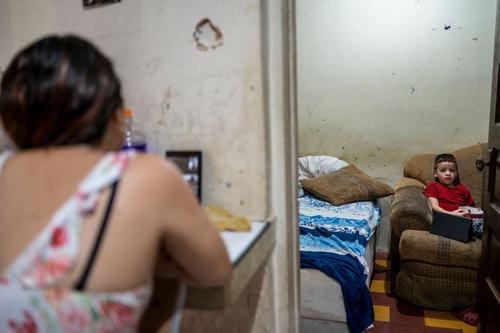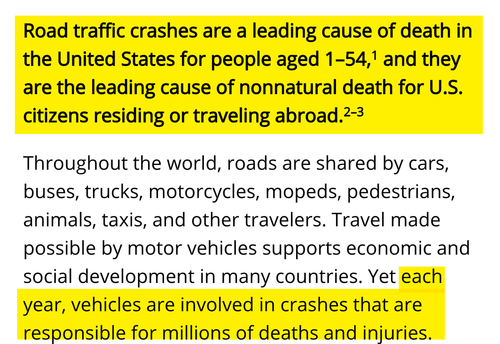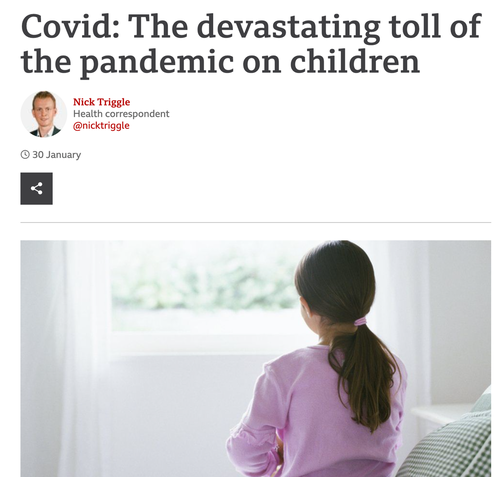Greenwald: The Bizarre Refusal To Apply Cost-Benefit Analysis To COVID Debates
Authored by Glenn Greenwald via greenwald.substack.com,

In virtually every realm of public policy, Americans embrace policies which they know will kill people, sometimes large numbers of people. They do so not because they are psychopaths but because they are rational: they assess that those deaths that will inevitably result from the policies they support are worth it in exchange for the benefits those policies provide. This rational cost-benefit analysis, even when not expressed in such explicit or crude terms, is foundational to public policy debates — except when it comes to COVID, where it has been bizarrely declared off-limits.
The quickest and most guaranteed way to save hundreds of thousands of lives with policy changes would be to ban the use of automobiles, or severely restrict their usage to those authorized by the state on the ground of essential need (e.g., ambulances or food-delivery vehicles), or at least lower the nationwide speed limit to 25 mph. Any of those policies would immediately prevent huge numbers of human beings from dying. Each year, according to the Center for Disease Control (CDC), “1.35 million people are killed on roadways around the world,” while “crashes are a leading cause of death in the United States for people aged 1–54.” Even with seat belts and airbags, a tragic number of life-years are lost given how many young people die or are left permanently and severely disabled by car accidents. Studies over the course of decades have demonstrated that even small reductions in speed limits save many lives, while radical reductions — supported by almost nobody — would eliminate most if not all deaths from car crashes.

Given how many deaths and serious injuries would be prevented, why is nobody clamoring for a ban on cars, or at least severe restrictions on who can drive (essential purposes only) or how fast (25 mph)? Is it because most people are just sociopaths who do not care about the huge number of lives lost by the driving policies they support, and are perfectly happy to watch people die or be permanently maimed as long as their convenience is not impeded? Is it because they do not assign value to the lives of other people, and therefore knowingly support policies — allowing anyone above 15 years old to drive, at high speeds — that will kill many children along with adults?
That may explain the motivation scheme for a few people, but in general, the reason is much simpler and less sinister. It is because we employ a rational framework of cost-benefit analysis, whereby, when making public policy choices, we do not examine only one side of the ledger (number of people who will die if cars are permitted) but also consider the immense costs generated by policies that would prevent those deaths (massive limits on our ability to travel, vastly increased times to get from one place to another, restrictions on what we can experience in our lives, enormous financial costs from returning to the pre-automobile days). So foundational is the use of this cost-benefit analysis that it is embraced and touted by everyone from right-wing economists to the left-wing European environmental policy group CIVITAS, which defines it this way:
Social Cost Benefit Analysis [is] a decision support tool that measures and weighs various impacts of a project or policy. It compares project costs (capital and operating expenses) with a broad range of (social) impacts, e.g. travel time savings, travel costs, impacts on other modes, climate, safety, and the environment.
This framework, above all else, precludes an absolutist approach to rational policy-making. We never opt for a society-altering policy on the ground that “any lives saved make it imperative to embrace” precisely because such a primitive mindset ignores all the countervailing costs which this life-saving policy would generate (including, oftentimes, loss of life as well: banning planes, for instance, would save lives by preventing deaths from airplane crashes, but would also create its own new deaths by causing more people to drive cars).
While arguments are common about how this framework should be applied and which specific policies are ideal, the use of cost-benefit analysis as the primary formula we use is uncontroversial — at least it was until the COVID pandemic began. It is now extremely common in Western democracies for large factions of citizens to demand that any measures undertaken to prevent COVID deaths are vital, regardless of the costs imposed by those policies. Thus, this mentality insists, we must keep schools closed to avoid the contracting by children of COVID regardless of the horrific costs which eighteen months or two years of school closures impose on all children.
It is impossible to overstate the costs imposed on children of all ages from the sustained, enduring and severe disruptions to their lives justified in the name of COVID. Entire books could be written, and almost certainly will be, on the multiple levels of damage children are sustaining, some of which — particularly the longer-term ones — are unknowable (long-term harms from virtually every aspect of COVID policies — including COVID itself, the vaccines, and isolation measures, are, by definition, unknown). But what we know for certain is that the harms to children from anti-COVID measures are severe and multi-pronged. One of the best mainstream news accounts documenting those costs was a January, 2021 BBC article headlined “Covid: The devastating toll of the pandemic on children.”
The “devastating toll” referenced by the article is not the death count from COVID for children, which, even in the world of the Delta variant, remains vanishingly small. The latest CDC data reveals that the grand total of children under 18 who have died in the U.S. from COVID since the start of the pandemic sixteen months ago is 361 — in a country of 330 million people, including 74.2 million people under 18. Instead, the “devastating toll” refers to multi-layered harm to children from the various lockdowns, isolation measures, stay-at-home orders, school closures, economic suffering and various other harms that have come from policies enacted to prevent the spread of the virus:
From increasing rates of mental health problems to concerns about rising levels of abuse and neglect and the potential harm being done to the development of babies, the pandemic is threatening to have a devastating legacy on the nation’s young. . . .
The closure of schools is, of course, damaging to children’s education. But schools are not just a place for learning. They are places where kids socialize, develop emotionally and, for some, a refuge from troubled family life.
Prof Russell Viner, president of the Royal College of Pediatrics and Child Health, perhaps put it most clearly when he told MPs on the Education Select Committee earlier this month: “When we close schools we close their lives.”
The richer you are, the less likely you are to be affected by these harms from COVID restrictions. Wealth allows people to leave their homes, hire private tutors, temporarily live in the countryside or mountains, or enjoy outdoor space at home. It is the poor and the economically deprived who bear the worst of these deprivations, which — along with not having children at all — may be one reason they are assigned little to no weight in mainstream discourse.
“The stress the pandemic has put on families, with rising levels of unemployment and financial insecurity combined with the stay-at-home orders, has put strain on home life up and down the land,” the BBC notes. But even for adults and those who are middle-class and above, severe and sustained isolation from community and life is bound to produce serious mental health harms, as two mental health experts I interviewed all the way back in April, 2020, warned.
None of this is to say that these are easy calculations. How COVID deaths or hospitalizations are weighed against the grave harms from anti-COVID restrictions is a complex question, one that almost certainly yields different answers in different countries and cultures. It may even yield a different policy answer in the same country as the virus and the social conditions which COVID produces evolve. One can debate how the contagiousness of COVID compares to the huge number of people who lose their lives or ability to lead healthy lives every year (so often, this argument is met with the more or less accurate but irrelevant distinction that COVID is contagious while car accidents are not: how does that bear on one’s willingness to endorse road policies (such as allowing driving cars at high speeds) that will inevitably kill large numbers of people or one’s refusal to consider the countervailing costs of anti-COVID measures?).
Put another way, this is not an argument in favor of or against any particular policy undertaken in the name of fighting COVID. What it is, instead, is an attempt to highlight the pervasive and deeply misguided refusal to assign any costs to the harms caused by anti-COVID policies themselves.
Perhaps this irrational mindset is explainable by the fact that COVID hospitalizations and deaths are more dramatic than the more insidious, lurking harms from sustained life disruptions. Perhaps the rapidly declining rates of child-rearing in the West make it more difficult to observe or care about the damage all of this is doing to the developmental abilities and mental health of children. Perhaps other factors — from a psychological desire for parental protection in the form of authoritarian power or a warped sense of “safetyism” — is rendering any cost-benefit analysis morally unacceptable. None of those speculative theories, however, accounts for the virtually unanimous refusal to consider a ban on cars or a 25 mph nationwide speed limit; that willingness to sacrifice huge numbers of lives by opposing life-saving automobile policies seems driven by the inconvenience such policies would impose on particular groups of people.
Whatever is true about motives, what is unacceptable — sociopathic, really — is the insistence on assigning severe costs to just one side of the ledger (harms from COVID itself) while categorically refusing to recognize let alone value the costs on the other side of the ledger (from severe, enduring anti-COVID disruptions to and restrictions on life). Given the reflexive rage that is produced when one tries to make this argument — what immediately emerges are accusations that one is indifferent to COVID deaths — I wanted to walk through the evidence and rationale demonstrating why this approach is reckless, immoral and irrational. That is the argument I examine in both this article and in the 30-minute video I produced for Rumble (which you can view on the player below, for now in a YouTube format, pending Substack’s enabling of the embedding of our Rumble videos).
(Note that this is the first video we produced in our new studio; we are aware that the studio lighting still needs serious adjustments (though the audio is now perfected); and we will soon provide transcripts for all videos we produce which exceed ten minutes for those who prefer to read rather than watch).
Tyler Durden
Wed, 08/25/2021 – 19:00![]()
Zero Hedge’s mission is to widen the scope of financial, economic and political information available to the professional investing public, to skeptically examine and, where necessary, attack the flaccid institution that financial journalism has become, to liberate oppressed knowledge, to provide analysis uninhibited by political constraint and to facilitate information’s unending quest for freedom. Visit https://www.zerohedge.com
